Mulch is an excellent addition to any garden. It stops weeds from developing, keeps pests at bay, and helps soil retain moisture. However, mulch can occasionally invite undesirable fungi into your garden. Generally speaking, Rid fungus mulch is not damaging to your plants, but its appearance could be an issue. So, what should you do? Read on to find out!
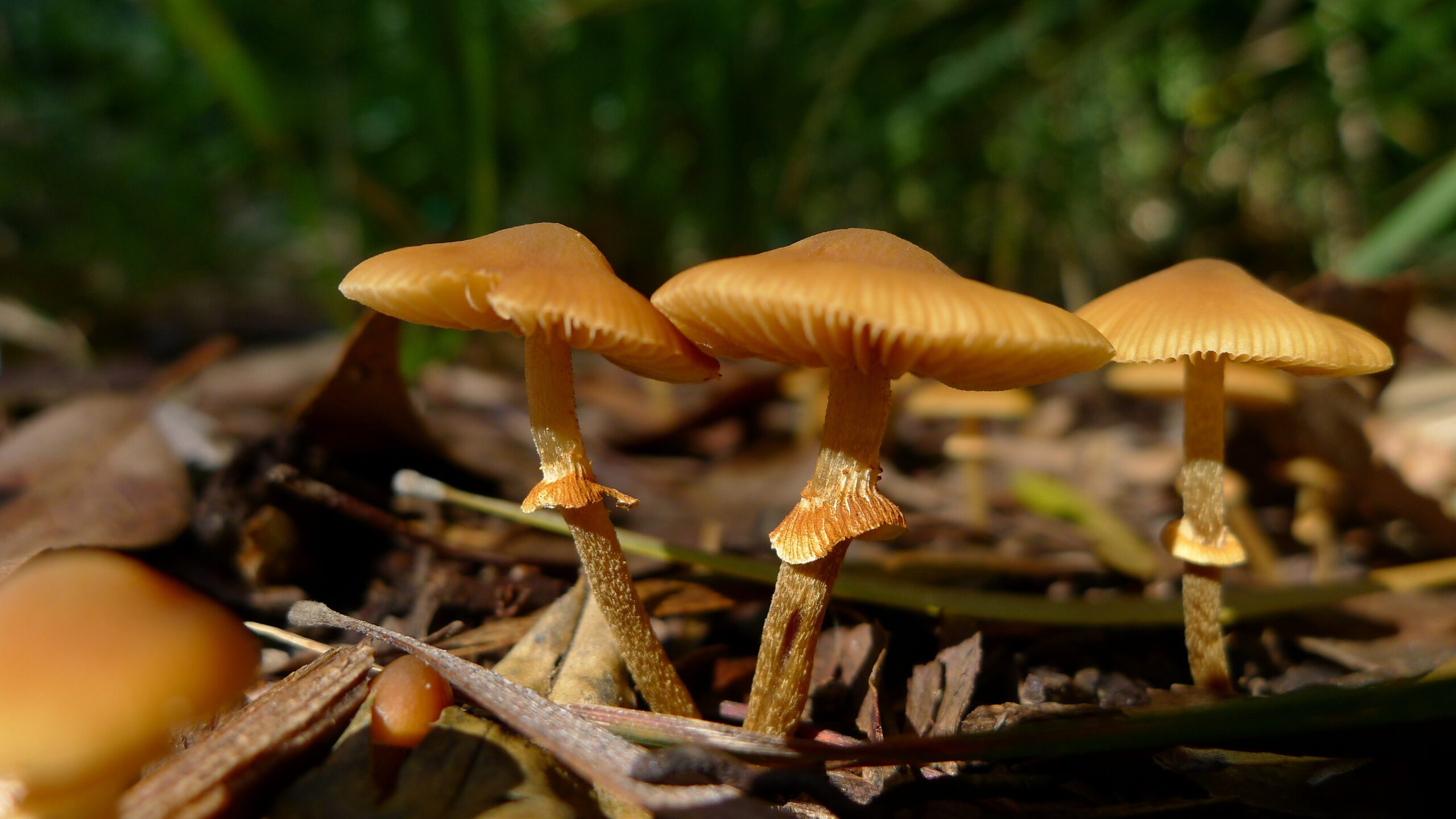
Although mulch can not directly cause fungal development, it might encourage it under the right conditions.
Mulch fungus is a nuisance that nobody wants to deal with, but unfortunately, it can arise at any time. It is also referred to as “slime mold” and “dog vomit” due to its lumpy and unpleasant look. To prevent the spread of mulch fungus, which can be difficult to eradicate once it has taken hold, treatment should begin as soon as the problem is noticed.
RELATED: How To Identify and Treat Common Fungal Diseases Of The Lawn | A Comprehensive Guide
The good news is that there are many methods available for efficiently and safely eliminating fungus from mulch beds. Among these are switching to a different mulch, using fungicides, adjusting the soil’s pH, speeding up decomposition, and raking the mulch. However, if you want the quickest and most outstanding results, we advise adopting a combination of these methods in your garden.
And how can you do that? Well, that is what this article is about!
How To Spot Fungus In Mulch?
At first, fungi appear as slimy, vividly colored masses that can be a few inches to a foot in diameter.
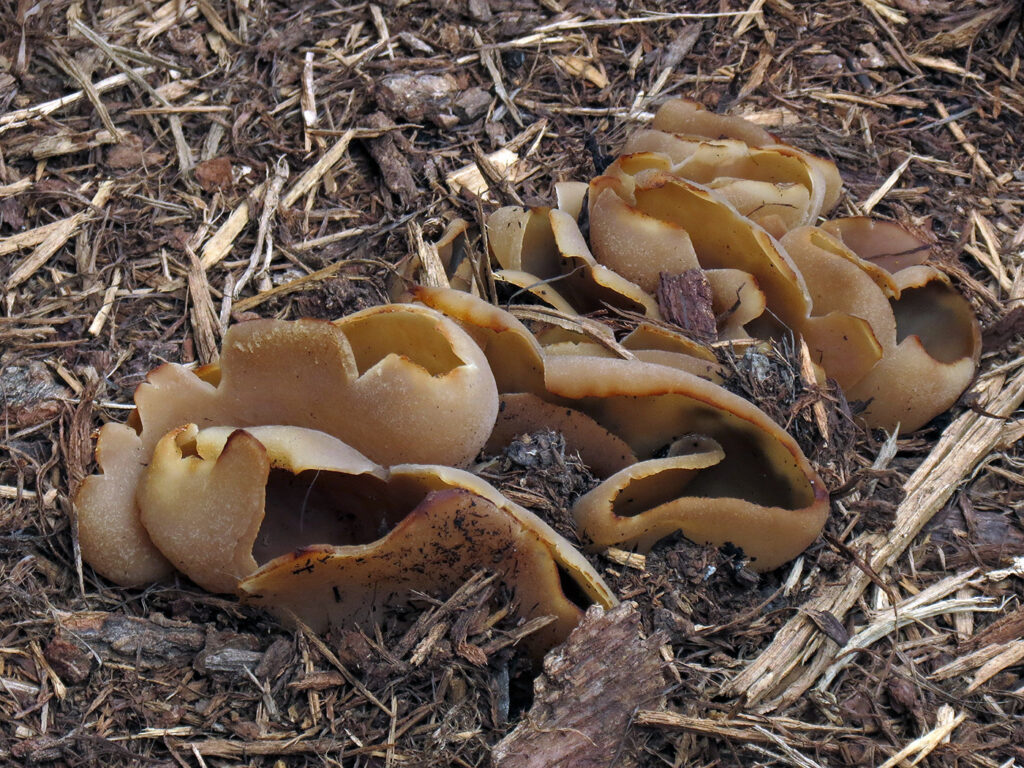
In nature, fungi come in a wide variety of shapes and sizes. There are millions of different kinds of fungi in the world. We suggest that you get in touch with your community’s agriculture department, nature center, or garden center for assistance if you are having trouble determining the species of mold that is growing in your mulch.
RELATED: Endophytes 101: The Friendly Fungi In Your Turfgrass | A Beginner’s Guide
In general, you will see a variety of fungi, such as bird’s nest fungus, slime mold, artillery fungus, and numerous types of mushrooms. Fungal growth is affected by a variety of environmental elements, including the temperature, humidity, and type of soil in the area where it is located. The most noticeable fungus, however, is a carpet of small-capped mushrooms growing in the mulch ranging in color from white to brown.
7 Common Fungus Types That Grow In Mulch
The best technique to treat your garden beds depends on your ability to identify the various varieties of mulch fungus that may be present. Home gardeners regularly find various fungus species growing in mulch, but not all of them are dangerous.
1. Dog Vomit Fungus
The so-called “Dog Vomit Fungus” is a type of slime mold that goes by the scientific name Fulgio septicai.
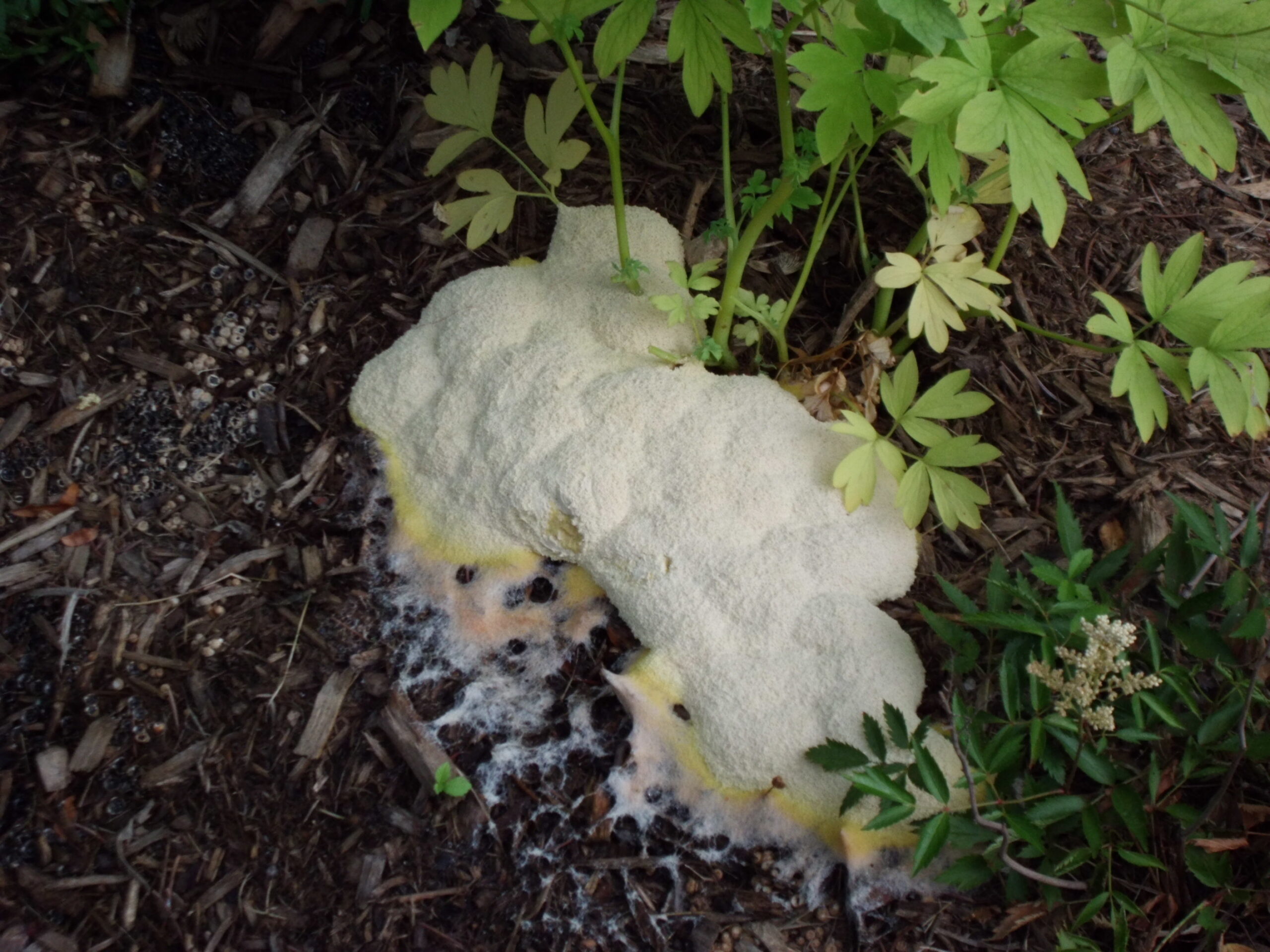
This peculiar “fungus” is actually a sort of slime mold, of which there are over 900 different varieties. It frequently manifests itself in moist areas on woody mulch and even on living plants from time to time. It does not cause diseases and will not cause any damage to your plants. In spite of this, the majority of people do not like to have them around since they do not find them to be aesthetically pleasing. In addition, their spores are capable of dispersing rapidly and without difficulty, and they can live for many years.
When it is new, it has a texture similar to that of dog vomit and an extremely slimy appearance. Also, slime molds, such as dog vomit and other slime molds, are saprophytic, which means that they feed on decomposing organic waste.
2. Bird’s Nest Fungus
Bird’s nest fungi are interesting mushrooms since they resemble nests with several little eggs.
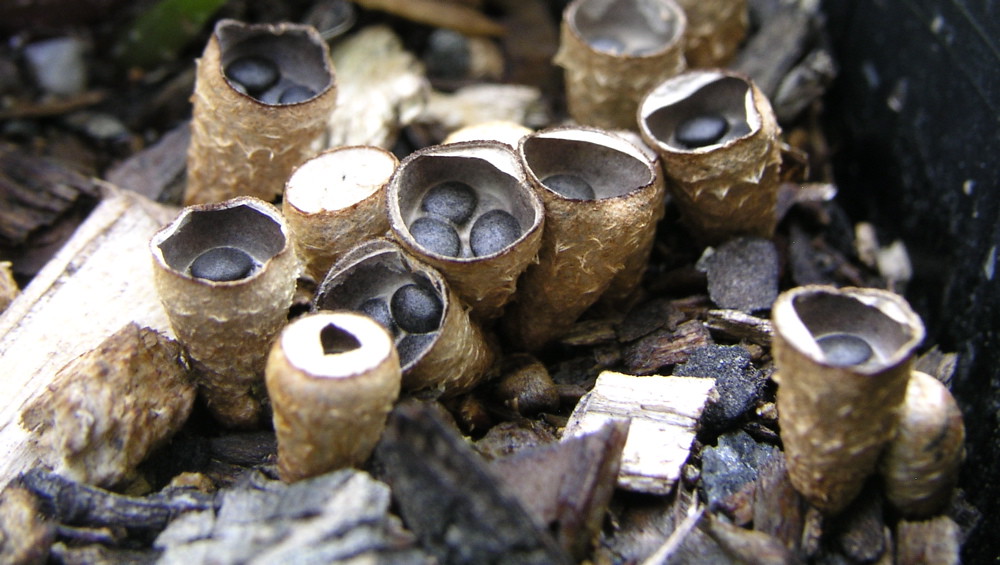
The bird’s nest fungus is not poisonous; thus, it is generally safe to keep it growing in your yard. In addition, many gardeners actually choose to compost fungal colonies of bird’s nest mushrooms found in their gardens, thus returning valuable nutrients to the soil.
Bird’s nest mushrooms are related to the typical fungi we buy in supermarkets, such as shitake mushrooms, button mushrooms, and oyster mushrooms, despite the fact that they have a very distinctive appearance compared to other types of fungi.
Gardens are a popular place to find the bird’s nest fungus in the fall when the weather turns cool and damp. Their favorite habitats consist of nutrient-dense soil, animal dung, rotting wood, and decomposing plant matter. Although bird’s nest fungus can be found in temperate locations practically any time there are moist and shady conditions, the fall is the season in which they are most frequently observed.
3. Stinkhorn Fungus
Stinkhorn is a type of stinking fungus, as one might expect from its name.
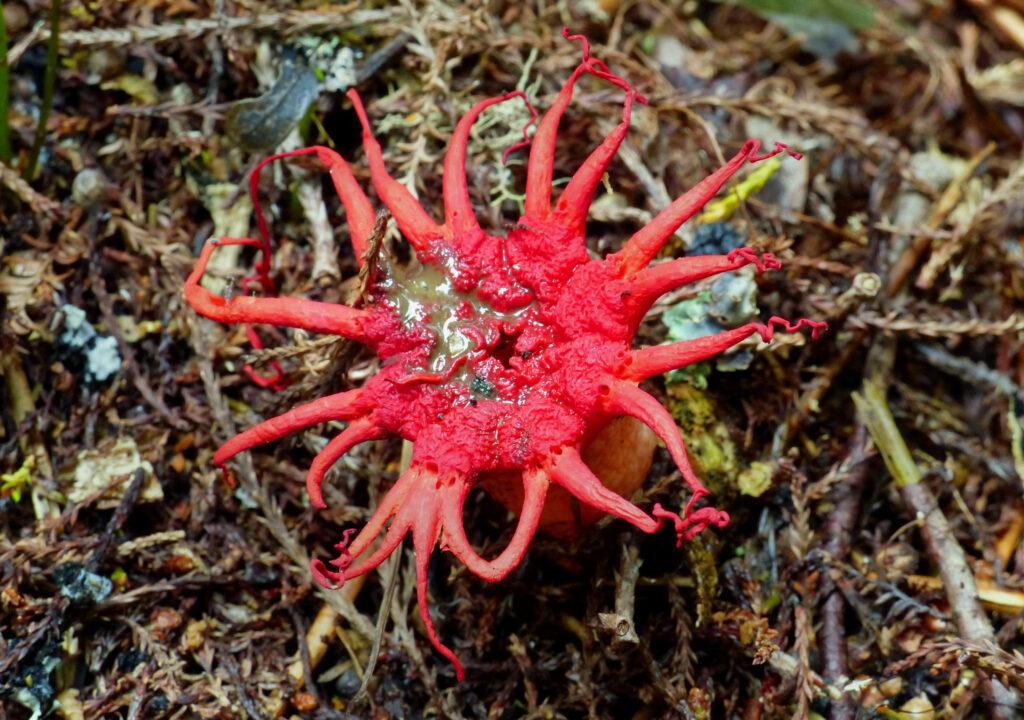
The color of a stinkhorn fungus can range from shades of reddish or orange to cream and brown. It often begins as a little ball and develops into a long stalk rounded at the end. The stinkhorn fungus appears out of nowhere in mulch, lawns, and regions with bare soil.
The common term for these visually stunning mushrooms comes from their distinctive, disagreeable odor. On their surface, these fungi create a slime that ranges in color from dark brown to black and contains spores. This slime emits a potent odor that is reminiscent of decaying meat or sewage. However, the fruiting bodies, often known as “mushrooms,” are typically the only part of the fungus that is visible to us.
These bodies develop from a network of hyphae, which are very fine filaments. There is no evidence that stinkhorns are poisonous. However, seek medical attention if there is any possibility that a child or a pet might have consumed a stinkhorn.
4. Mushrooms
For mushrooms, nothing could be better than the rich, rotting materials that mulch provides.
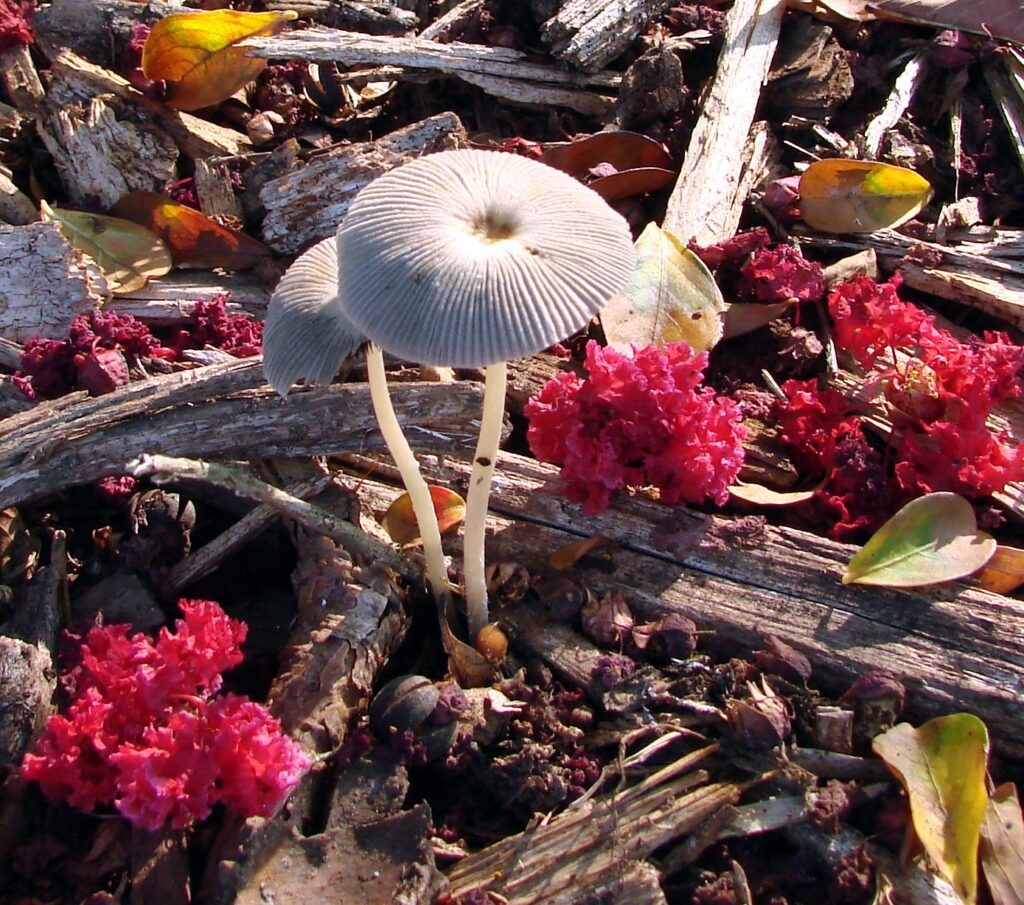
It happens more often than you might imagine that different types of grass mushrooms will grow in mulch beds. In contrast to the growth of plant spores, which takes place in the soil, the development of mushroom spores takes place in organic matter such as wood chips or straw. In addition, mushrooms thrive best in humid settings.
This is because wet conditions hasten the breakdown of biological molecules. It is not always difficult to identify mushrooms growing in your garden. After all, they frequently take the form of an umbrella. Even though they do not threaten the health of plants, mushrooms growing in mulch can be an unsightly sight in flower beds and gardens.
And despite the fact that they give the impression of a garden that has not been cared for, mushrooms actually indicate that the area is healthy.
5. Artillery Fungus
The artillery fungus is a type of wood-rotting fungus that favors humid landscape mulch as a habitat.

The artillery fungus is a type of wood-rotting fungus that the unattractive blotches may identify it leaves behind on objects that are in close proximity to it. People frequently think that these are tar marks, scale insects, or insect frass when in fact, they are not.
The fungus can be identified by its appearance, which is similar to areas of scaly soil or mud and can be found on light-colored dwellings, cars, and outdoor surfaces. In addition to that, it is present in bark mulches and manure. It is most at home in wide-open spaces with relatively little tree cover and adequate humidity.
If there is enough light, the ideal temperature range for the formation of fruiting bodies is between 10 and 20 degrees Celsius. Therefore, it is safe for use around people and animals and will not harm the plants in your garden. The artillery fungus is easily identifiable due to its fruiting bodies, which are cup-shaped and very tiny. Each cup is a different shade of cream, orange, or brown and contains a single small black spore.
6. Yellow Fungus
The yellow slime mold fungus thrives in damp places in your garden, on wood mulch, or chips.
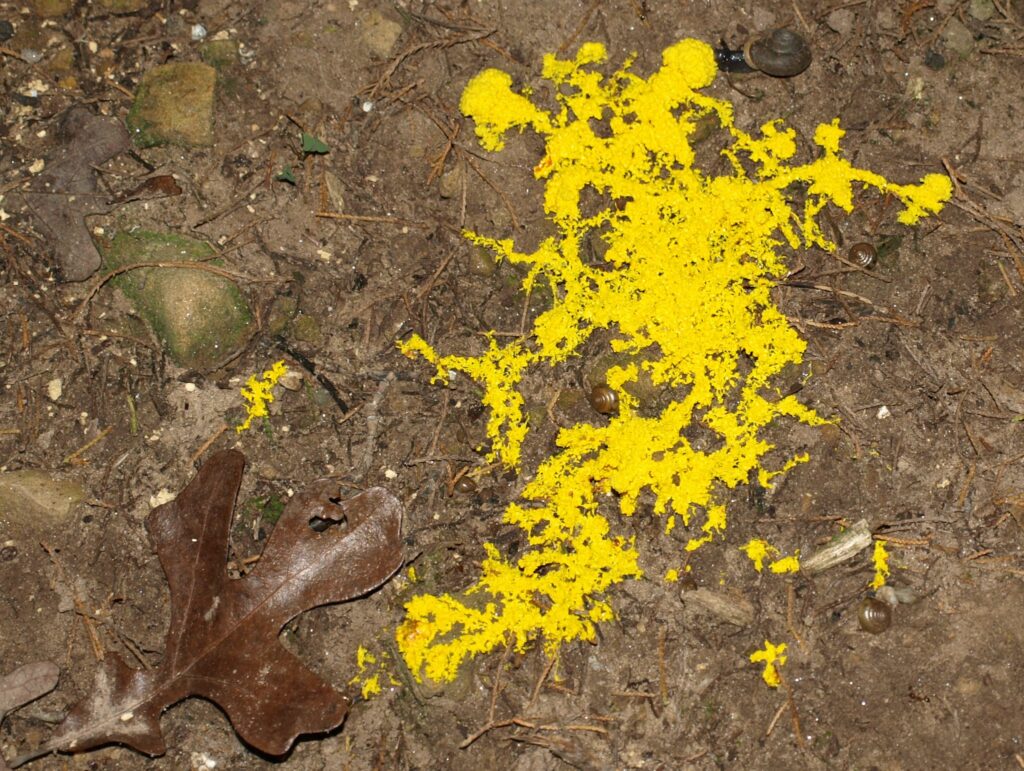
The yellow fungus appears on the mulch’s surface when moisture levels are high enough. Even while the yellow fungus does not threaten the people, plants, or garden in your home, it can be unpleasant. The only exception to this would be people with allergies.
Mold spores are released as the mold dries off, and these spores can make persons with allergies very uncomfortable and can also worsen asthma and other respiratory diseases. Certain types of slime mold have an appearance that ranges from brilliant yellow to gold, which can damage the aesthetic of a flower bed that has been well maintained.
7. Orange Fungus
The orange fungus growing in your mulch is a slime mold known scientifically as Physarum polycephalum.
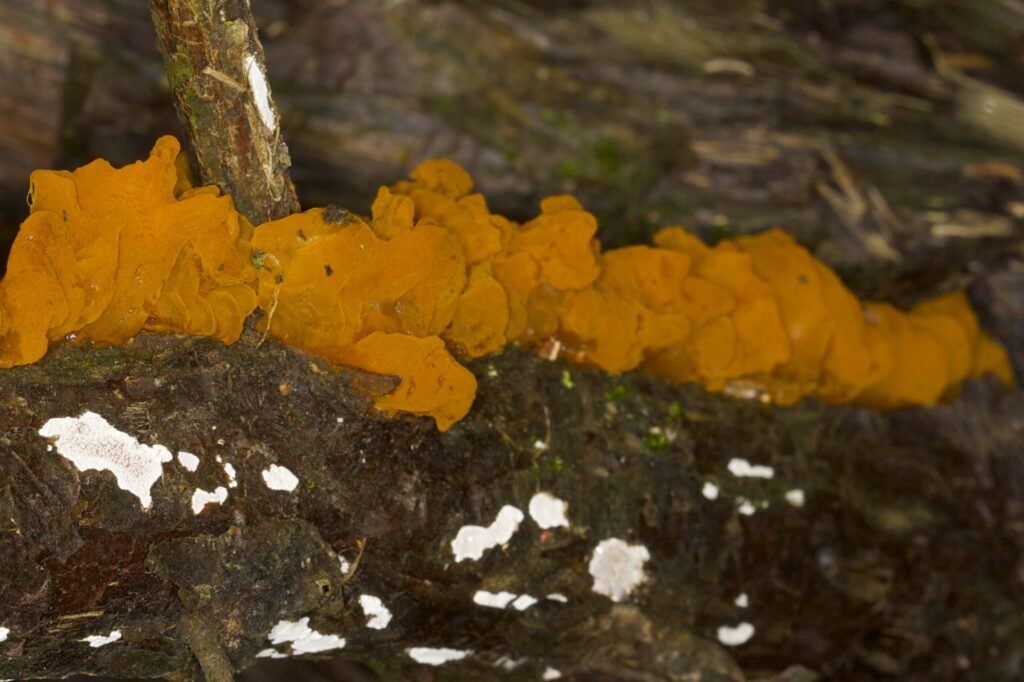
The orange fungus that is found in mulch is typically an uninvited and unwelcome guest that infects many people’s home gardens. Mulch orange fungus is usually orange in color, but it can also be yellow. There is a good chance you are dealing with a slime mold if you find an orange fungus in your garden or mulch.
RELATED: Orange Mushrooms In The Yard? Here Is How To Get Rid fungus Of Them!
At first, slime molds manifest themselves as bright yellow or slimy orange clumps that can span a distance of more than 12 inches. Although the hue may look threatening, orange fungi are typically entirely safe, despite their unattractive appearance.
If the presence of some pulsing slime in your flower beds doesn’t bother you, there’s no need to remove it. It is a natural element of the decomposition process, and neither you nor your dogs need to worry about its presence.
Is It Possible To Prevent Mold Growth In Mulch?
Mold growth can be greatly reduced, if not eliminated altogether, with the correct application of mulch materials.
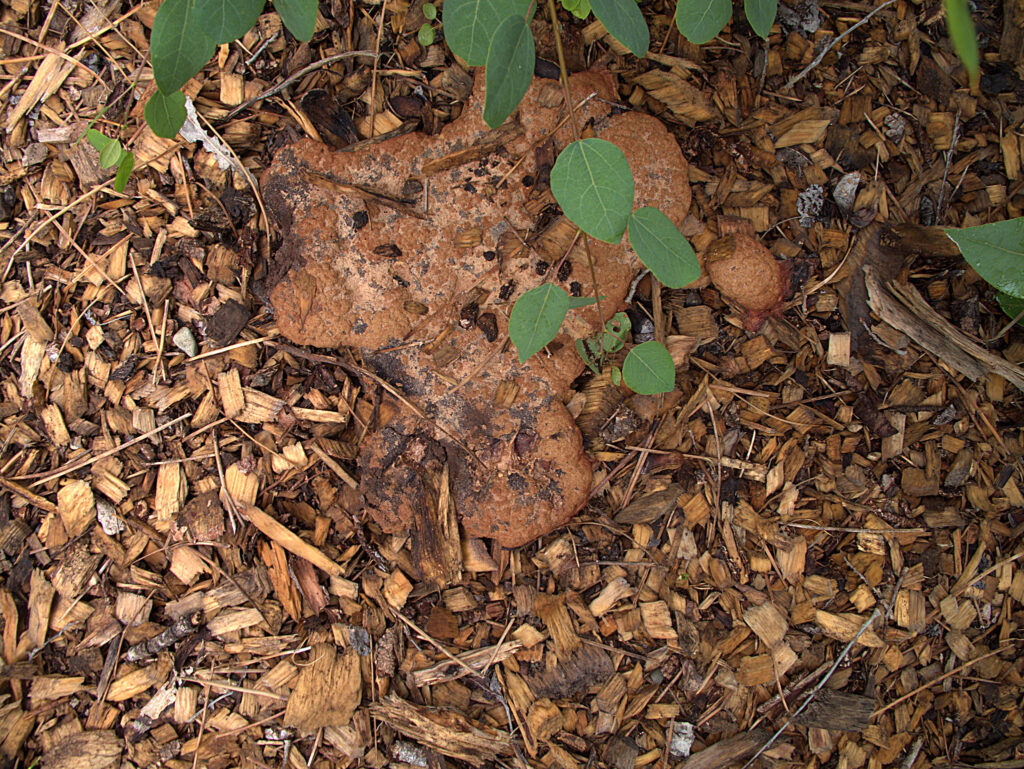
Even if you are familiar with the methods for removing fungus from mulch, the best course of action is always prevention. Creating an environment that is hostile to mold spores is the most effective method for preventing new growth from occurring. They require a damp and consistent climate in which the sprouts can take root and grow.
Raking your mulch on a regular basis is an excellent method for preventing it from becoming contaminated with mold. Mold can only grow and thrive in moist environments and contain moisture; this is one reason why raking can greatly help.
If you rake your mulch regularly, it will be able to obtain fresh air and dry out, thereby preventing mold growth. Moreover, if you want to prevent mold growth in your mulch, altering the timing at which you water it might be helpful.
Try watering your garden early in the morning so excess water can evaporate during the day. It is also important to remember not to water the tops of your plants when you are watering them. Furthermore, to prevent your plants from being overcrowded, use soil that drains effectively and ensure adequate space between each of them.
Can Pets And People Get Sick From Mulch Fungi?
In rare situations, the spores of the mulch fungus can be hazardous to humans if inhaled.
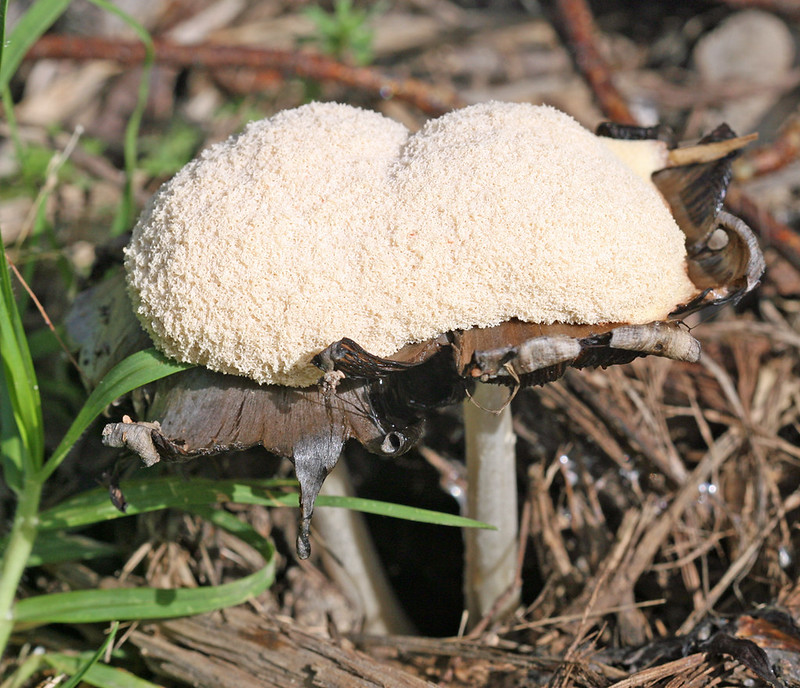
When the temperature and humidity levels simultaneously rise, a typical problem that can develop on mulch is slime mold. When mixed with organic matter such as hardwood mulch, slime mold is able to develop and rapidly spread throughout an area.
Although it is unpleasant to look at, slime mold does not pose any health risks to either humans or animals. These fungi are natural components of the ecosystem in which mulch is found. They do not cause any harm to the plants that are used in landscaping, and there are no known health risks linked with them unless they are consumed.
In spite of this, it is best to get rid Fungus of any growth that you discover as quickly as you can.
If you do this, you will avoid any unintentional ingestions that could result in indigestion or poisoning. In rare situations, the spores of the mulch fungus can be hazardous to humans if inhaled. For example, if an individual has severe allergies or asthma, or their immune system is impaired in any way, they may become ill from breathing in spores.
Is Fungus In Mulch Harmful To Your Garden?
Despite their smell and occasionally unusual appearance, these fungi are harmless to the garden.
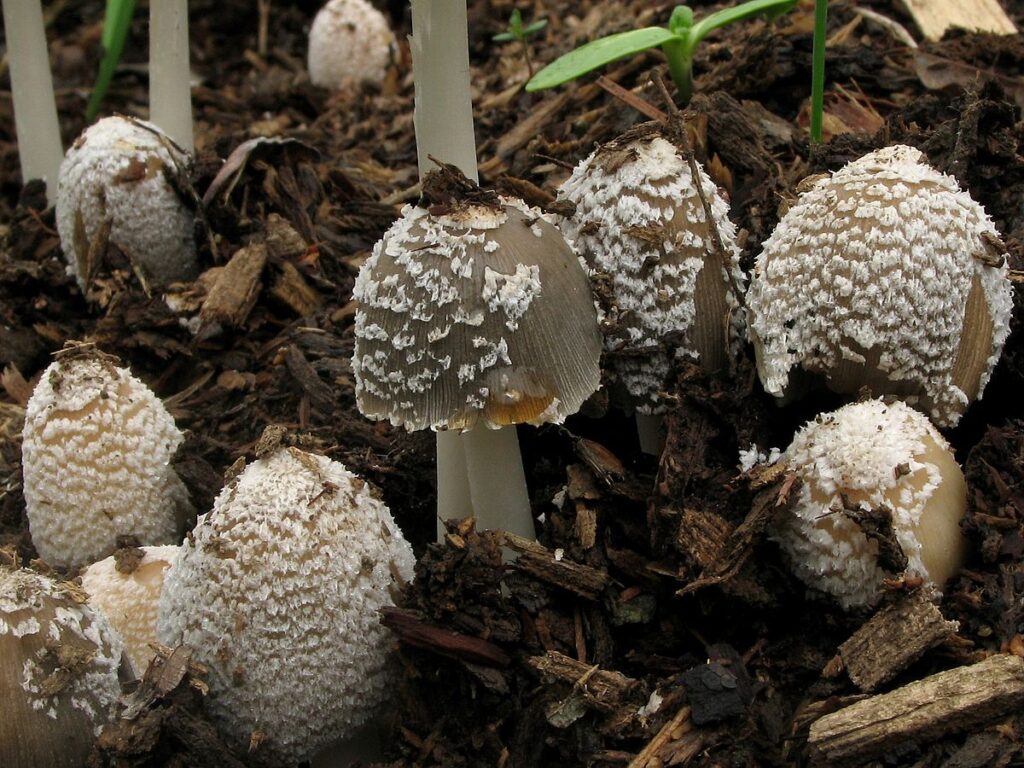
Moldy mulch is normally harmless to the plants it is applied on. However, it may indicate an excess of moisture in the soil around the plant; therefore, you should be careful about how much water you give your plants, particularly during periods of rain.
Aesthetically speaking, fungus mulch may present a problem, even though it typically does not cause any harm to the plants it surrounds. In fact, and scientifically speaking, they offer quite a few advantages to your yard too, which you should look forward to.
These fungi increase the decomposition of mulch, which results in the release of nutrients that are returned to the soil and plants when the mulch decomposes.
What Causes Fungus In Mulch?
Although mulch can not directly induce fungal growth, it might encourage it under the right conditions.
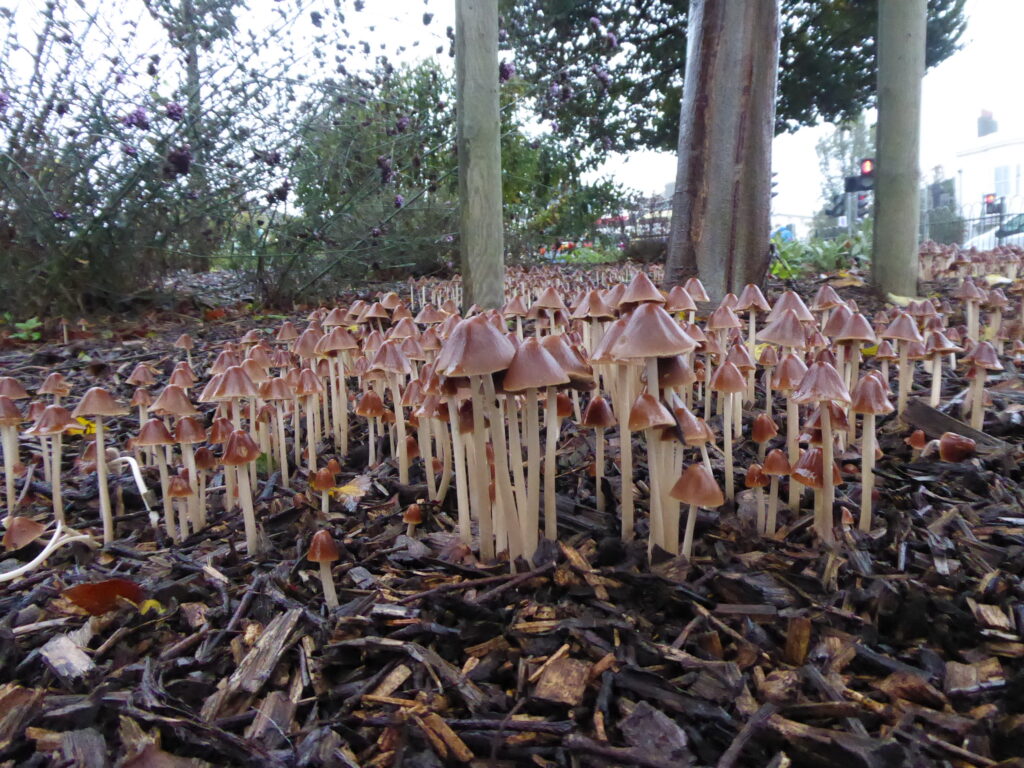
While some species of fungus feed on decomposing organic matter, such as rotting wood or dead leaves, others feed on the bacteria that are growing inside the mulch bed. It is very normal to observe the growth of fungi in your mulch so long as the environment is warm and moist and there is enough food. In the course of the life cycle of mushrooms, a fertile fruiting body will discharge spores into the surrounding air.
These spores can travel a long way from the plant they came from before they settle down. This means that a fungal infection in a neighbor’s yard could easily spread to yours.
Once a spore has established itself in its new place, it will either remain dormant until conditions become more suitable or it will begin to sprout. When spores land in mulch, they are frequently in an optimal environment to germinate, grow, and reproduce, which can lead to an infection outbreak in other parts of your garden.
How To Get Rid Of Fungus In Mulch?
After a certain amount of time has passed, with the growth of the fungus unchecked, it may be difficult to eradicate the existing fungal colonies. The most effective strategy for dealing with mulch fungus is to address the problem as soon as it arises. The following is a list of quick and simple methods that can be used to eliminate fungus in mulch:
1. Baking Soda
Sodium Bicarbonate, a safe and effective fungicide, treats many fungal infections and infestations.
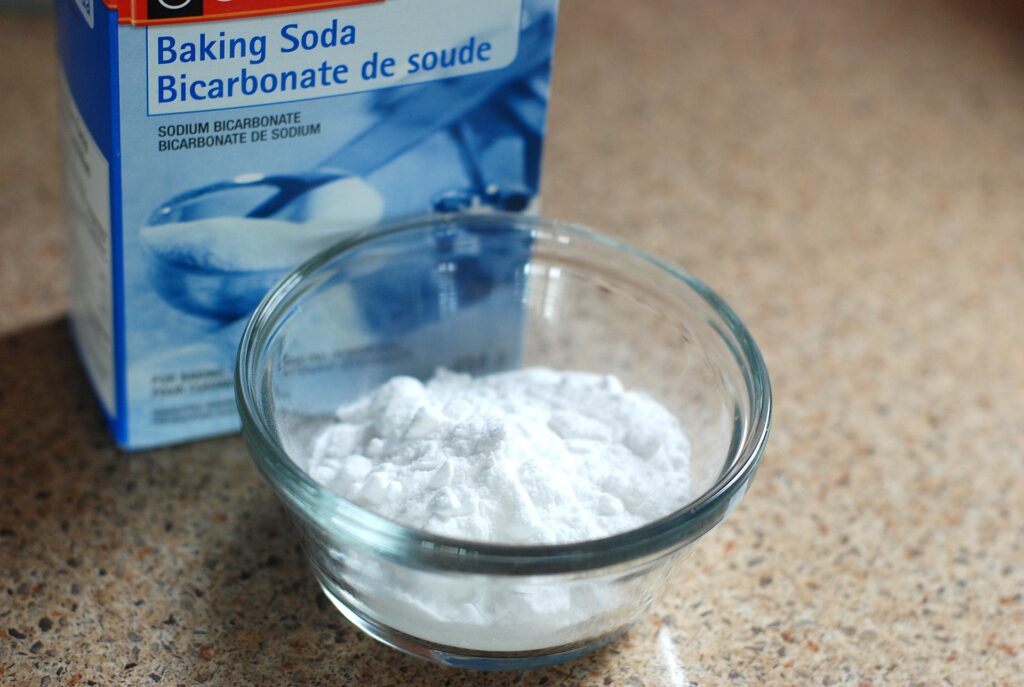
Baking soda has long been used as a fungicide by enthusiastic gardeners. When baking soda is sprinkled on mulch, it raises the pH of the soil and makes it unsuitable for acid-loving fungi to grow. Just add one spoonful of baking soda to a gallon of water and stir until dissolved. When you add the liquid soap, be sure to mix it very well.
Add the solution to a clean, empty spray container, give it a good shake, and then apply it to the affected region. If the problems persist after 7 to 10 days, apply the solution again.
Sprays containing baking soda should be kept out of the reach of children and clearly marked as such. Don’t worry if you have any spray left over; it can be stored in the bottle for future use. Before using, give the spray bottle a quick shake.
2. Cornmeal
Cornmeal is prepared by grinding yellow corn into a powdery or granular form.
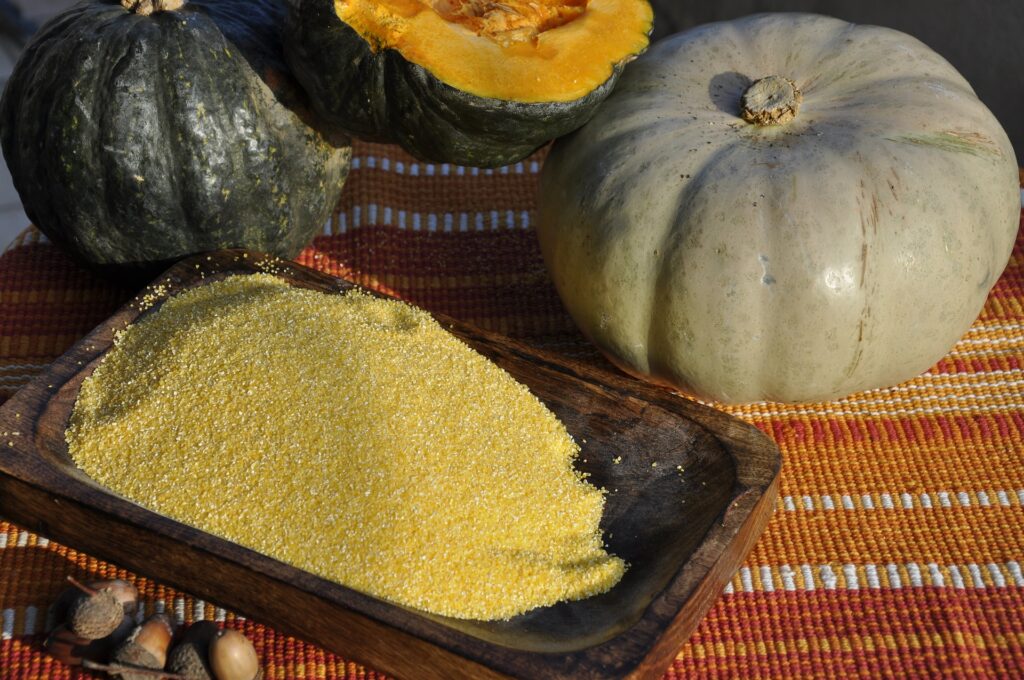
Mix water and cornmeal together to form a thick paste, which should then be applied to the area that has the fungal colony. For optimal results, mix one cup of cornmeal with one gallon of water that has been cooled to room temperature or left at room temperature.
Cornmeal is a popular choice among gardeners as a treatment for mulch fungus, despite the fact that it may appear to be an unusual cure at first. It has antifungal components that serve to eliminate living growth and may even aid in preventing future infestations. Cornmeal has also been shown to be effective against yeast infections.
3. Fungicides
Fungicides are another treatment option for mulch fungus. However, it is important to note that no recognized fungicides can be used to treat artillery fungus. Fungicides that are less hazardous and have a higher organic content might simply be the best option.
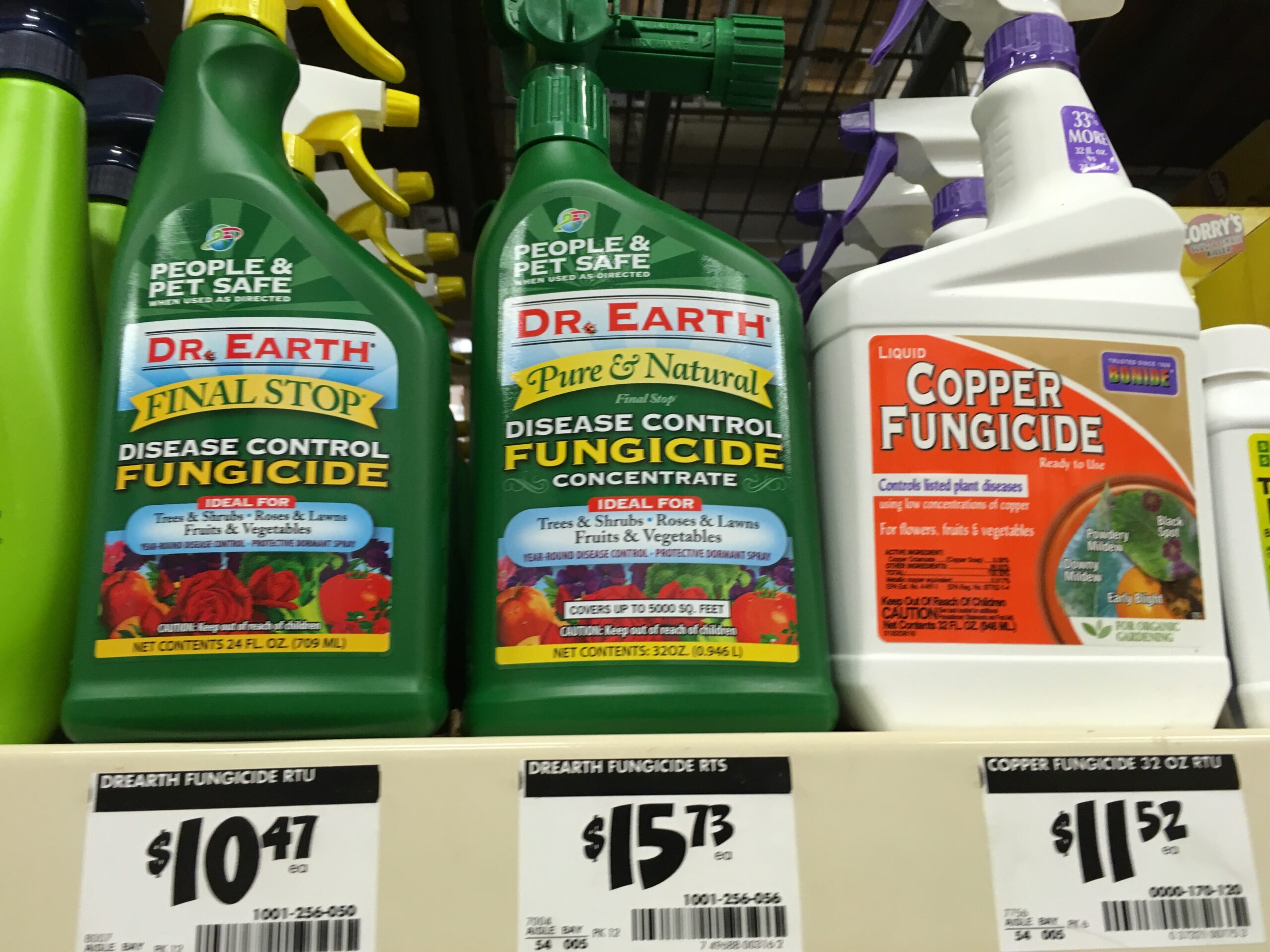
This is because they pose a low risk of harm to people and other animals. In addition, research has shown that their impact on the environment is far less.
Also, when applying fungicides, whether organic or not, you should always take precautions to protect yourself. You need to protect any skin that is exposed along with your eyes, nose, and mouth. While you are working, it is recommended that you wear protective eyewear such as goggles or glasses in addition to a mask or respirator.
4. Adjust The Mulch PH
Increasing the pH of the soil is another strategy for reducing the amount of fungal development. Since fungi thrive in more acidic soil, a pH level of seven or higher should normally start to have a detrimental impact on the health of the fungi.

The addition of lime liquid is one way to accomplish this. Apply a little bit of this combination by sprinkling it on or spraying it straight onto the mulch. Take care not to get it on any plants and avoid using too much of it, as there is a possibility that it could be harmful to the plants. The pH of mulch can also be improved by using wood ash.
5. Remove Fungi By Hand
Always wear long sleeves, pants, boots, and thick gloves when hand-removing mulch fungi.
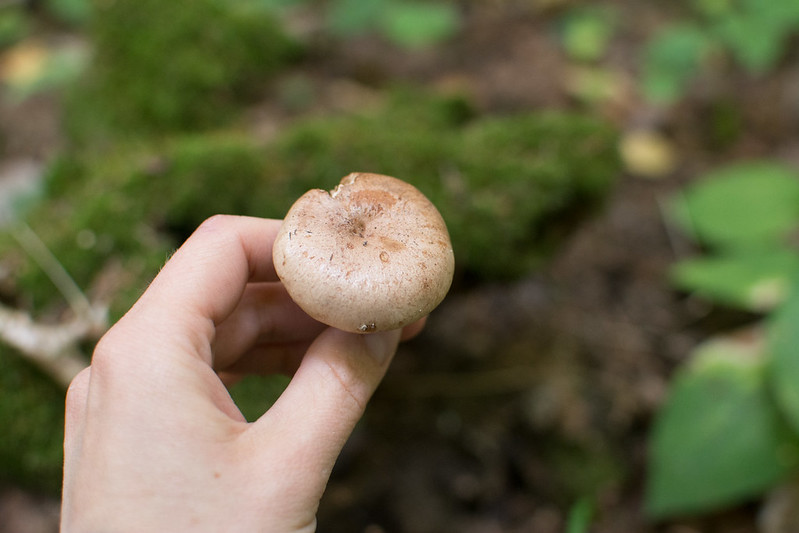
Removing mushroom colonies by hand is one of the most straightforward methods to eliminate mulch fungus and mushrooms. Fungi, such as mushrooms and toadstools, are ideal candidates for this procedure since their bodies are straightforward to identify and manipulate. However, when manually removing fungi, protective gear must always be used.
Some mushrooms and other common fungus may include minor skin irritants or cause an allergic reaction, despite the fact that the vast majority of these organisms are perfectly safe to touch. Therefore, after the fungal bodies have been removed, the upper surface of mulch in any infected garden beds should be removed using a scraper.
If this does not happen, living materials such as mycelium may stay underground and eventually re-grow, resulting in more infestations.
Final Thoughts
The fungus that grows on mulch is not harmful to plants and occurs naturally since the fungus feeds on the microorganisms that are responsible for the mulch break down. As a result, the vast majority of mulch fungal treatments are pointless.
On the other hand, fungus growing in your mulch bed can make it look unpleasant. To your good fortune, there are a plethora of methods that are risk-free, simple, and economical for removing fungi from your mulch bed.
Frequently Asked Questions (FAQs)
How do I get rid of the fungus in my mulch?
Stopping the spread of mulch fungus is as simple as making an antifungal spray out of a mixture of one part vinegar and four parts water. Apply it to the mold by spraying it on, then do it again in a few days. As time goes on, the fungus on your mulch will die off, and everything will be fine.
Why do I have fungus growing in my mulch?
Many fungal species derive their nutrition from decomposing organic matter, such as rotting wood, while others feed on bacteria forming inside the mulch bed. Fungi are natural components of the environment surrounding mulch and play an essential role in the degradation of landscape mulches. So, there is often no reason to be concerned about them.
Is mulch fungus harmful to humans?
While many common garden fungus are harmless to the touch, this does not necessarily mean they are edible. Humans are known to be vulnerable to the health effects of fungal spores and the wood dust that comes from mulch. If the spores of the mulch fungus are breathed in by humans, there is a slight chance that they will cause illness.
Sources for Further Reading
Fungi in Mulches and Composts. (2015). Retrieved 7 November 2022, from https://ag.umass.edu/landscape/fact-sheets/fungi-in-mulches-composts#:~:text=Wood%20chip%2Fbark%20mulches%20and,nest%20fungi%2C%20stinkhorns%20and%20mushrooms.
Artillery Fungus and Other Things That Grow in Mulch | Cooperative Extension | University of Delaware. (2022). Retrieved 7 November 2022, from https://www.udel.edu/canr/cooperative-extension/fact-sheets/artillery-fungus-mulch/
Rettke, S. (2021). Control of Nuisance Fungi in Landscape Mulch. Retrieved 7 November 2022, from https://plant-pest-advisory.rutgers.edu/control-of-nuisance-fungi-in-landscape-mulch/
We hope you learned something from this article, here are other articles that you can learn from:
How Cold Is Too Cold To Fertilize Your Lawn? A Comprehensive Guide
Do Brand New Lawn Mower Blades Need To Be Sharpened? A Beginner’s Guide







